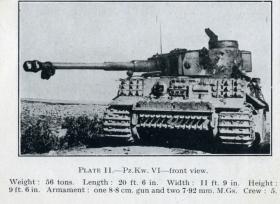The Sonderkraftfahrzeug (Special Purpose Vehicle or SDKFZ) 181 Tiger 1, commonly known as the German Tiger 1 Heavy Tank was designed by Porsche in 1941 in response to the increasingly heavy tanks being fielded by the Russian Army.
Weighing a massive 56 tonnes and armed with the formidable 88mm main gun, the Tiger dominated all allied tanks in the period 1942 to 1944. Its main weakness was its Maybach engine which was underpowered when compared to the size of the vehicle.
The Tigers wide tracks and Torsion bar suspension, however, provided for good cross country performance, but the overlapping wheel design proved a heavy maintenance overhead.
Airborne forces were initially equipped with the Projector Infantry Anti Tank (PIAT) to deal with German tanks, but with a range of only 90m and unable to penetrate the frontal armour of a Tiger the operator had to be calm and well concealed to be effective.
Later the 6-pounder, and much improved 17-pounder Anti-Tank guns became available and were transported in Horsa gliders. These provided Airborne Forces with the ability to strike back at enemy tanks, with the 17pdr being able to knock out the Tiger at 1,000m.
Both versions were used at Arnhem with Sgt John Baskeyfield, of the South Staffords earning a Victoria Cross manning a 6pdr and knocking out two Tigers.
Only 1,400 were produced during the war, but they became the most famous of German tank designs.
Statistics
Weight: 56.9 tonnes or 62.72 tons
Length: 6.29 m (20 ft 8 in), or 8.45 m (27 ft 9 in) with gun forward.
Width: 3.55 m (11 ft 8 in)
Height: 3.0 m (9 ft 10 in)
Crew: 5
Armour: 25–120 mm (0.98–4.7 in)
Primary armament: 1× 8.8 cm KwK 36 L/56 with 92 rounds
Secondary armament: 2× 7.92 mm MG 34 with 4,800 rounds
Engine: Maybach HL230 (V-12 petrol) (690.4 hp)
Range: 110–195 km (68–121 mi)
Speed: 38 km/h (24 mph)











Latest Comments
There are currently no comments for this content.
Add Comment
In order to add comments you must be registered with ParaData.
If you are currently a ParaData member please login.
If you are not currently a ParaData member but wish to get involved please register.